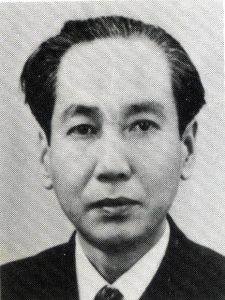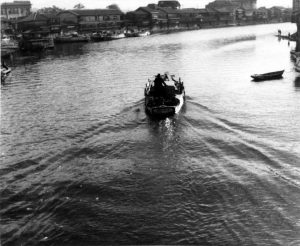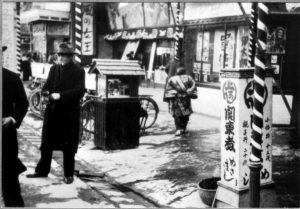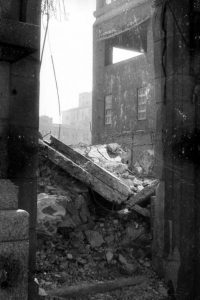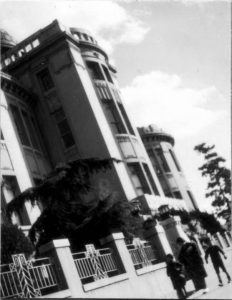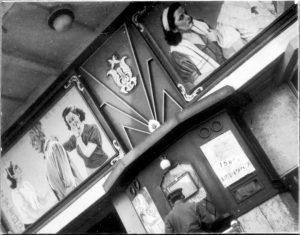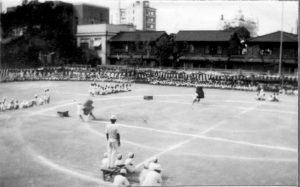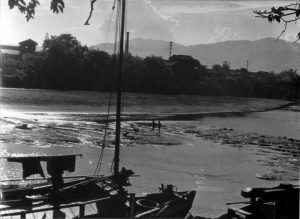Striving to fill voids in Hiroshima — Recreating cityscapes: Photographer’s record of changes taken from citizen’s viewpoint donated to Peace Memorial Museum by bereaved family
Jan. 6, 2025
People living together with river, flourishing movie theaters
by Kyoko Niiyama, Staff Writer
Taichi Morimoto, a professional photographer who operated a photography studio in Hiroshima during the war and died in 1978 at the age of 61, kept a detailed record of the city’s changes from before the atomic bombing through the post-war recovery period. At the end of 2024, around 50 photographs taken by Mr. Morimoto compiled into three photo albums were donated by members of his bereaved family to the Hiroshima Peace Memorial Museum. Along with other photos already archived there, the museum’s collection now contains a total of around 210 of his photos. The Chugoku Shimbun herein will introduce some of the photos from among the collection that capture the cityscapes and people until “that day,” August 6, when a single atomic bomb annihilated the city.
Mr. Morimoto studied photographic techniques at the Oriental School of Photography in Tokyo and later opened a photo studio at his house in his hometown of Nobori-cho (in Hiroshima City’s present-day Naka Ward).
Around 120 of his photos predate the atomic bombing and are presumed to have been photographed from the 1930s to the 1940s. One was taken from Motoyasu Bridge, located near the hypocenter, facing southeast and showing a ferryboat crossing the river as well as the cityscape in the area of Ote-machi (in Hiroshima’s present-day Naka Ward). The photo also includes the three-story, ferroconcrete headquarters of the Hiroshima Gas Company (present-day Hiroshima Gas Co., Ltd.). Hironobu Ochiba, chief curator at the Peace Memorial Museum, said, “Photographs taken before the atomic bombing that depict the entire area to the south of the Prefectural Industrial Promotion Hall (present-day A-bomb Dome) are a rarity. We can clearly see how buildings stood side-by-side along the river.”
In the bustling commercial area of Hatchobori, Mr. Morimoto took photos of two movie theater buildings. One captures the Toyo-za movie theater, with people passing by in front of the entrance. A photo of the Taiyo-kan movie theater includes a shot from the rear of a man standing at the ticket booth.
According to Hiroyuki Morimoto, 79, Mr. Morimoto’s second son who lives in Hiroshima’s Asakita Ward, when his father took photos as a hobby, he liked to point his lens at landscapes. Including one of children playing in Kyobashi River at low tide, he would take photos of everyday life before the atomic bombing from the viewpoint of a citizen.
The everyday life in the city photographed by Mr. Morimoto was entirely lost on August 6, 1945. His home, located around one kilometer from the hypocenter, was burned to the ground. His family was able to avoid hardship because they had evacuated outside of the city. His photographic prints were said to have been saved because they had also been evacuated. Mr. Morimoto experienced the end of the war in Yamaguchi Prefecture, where he had been deployed for military service. Later, he apparently entered the Hiroshima city area with his favorite Leica camera in hand.
Mr. Morimoto did not speak much about that time to his family, except to say that, “I simply could not take photos of wounded people who had experienced the atomic bombing.” He gave up on rebuilding his photo studio but did join in the formation in 1978 of the Association of Photographers of the Atomic Bomb Destruction of Hiroshima, along with other photographers, including the late Yoshito Matsushige, a former photojournalist for the Chugoku Shimbun. Some of the photos taken by Mr. Matsumoto are included in the “Visual archives of Hiroshima atomic bombing—Photographs and films in 1945,” which is now a candidate for listing with the United Nations Educational, Scientific and Cultural Organization (UNESCO)’s “Memory of the World” International Register.
Hiroyuki, Mr. Morimoto’s son, said, “If it had not been for the war and the atomic bombing, my father would likely have continued to work actively as a photographer after the war.” He added, “Something is certainly revealed from his photos. I hope they can be utilized for research into and communication about the damages caused by the atomic bombing.” That is our wish prior to the 80th anniversary of the atomic bombing.
The Chugoku Shimbun is now soliciting photographs of Hiroshima’s cityscapes and its citizens’ daily lives taken between around 1930 and August 5, 1945. Following your submission and our scanning of any submitted photos or photo albums, the materials will be returned to you. For further details, please send an email to peacemedia@chugoku-np.co.jp, or call us at 082-236-2801.
Around 1,300 photos of Hiroshima taken before the city’s destruction in the atomic bombing have been superimposed on a Google map and are posted on our “Striving to fill voids in Hiroshima” website. Please access the site at: https://hiroshima75.web.app/map/#.
(Originally published on January 6, 2025)

